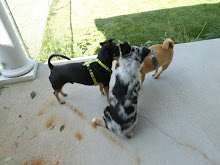Sunday, August 17, 2014
Monday, August 11, 2014
Blocking Needlepoint
It's been a few years since I've made a needlepoint pillow. I actually had several partially finished kits in my possession that I abandoned years ago, and just now decided to complete them before starting my next quilting project. However, the canvases were stretched out like parallelograms and I needed them to be square before sewing the backing onto the needlepoint canvas. The instructions told me to "block" the canvas, but didn't elaborate. Thank goodness for the Internet. I learned that I needed some cork board and pins or tacks.
We found a large cork bulletin board at our local hardware store for about $30 and I was able to block two needlepoint canvases at once. You pin the canvas up, spray it with water, and then pull and pin until you shape it into a square. Then you let it dry, and if it needs additional re-shaping, you do it again. You are supposed to test the yarns for colorfastness, meaning that you take a piece of each color yarn, lay it on a paper towel, and wet it down. If it bleeds, you have to dry block the canvas. I never got that far, because I figured that with dogs in the house, the yarns had better be colorfast because I'm going to be washing these pillows constantly, and if they bleed, so be it.
The pleasure is in the process, right? Who cares if the pillow actually lasts. Here is a picture of the blocking process...
I had put the lip cord around the edge of the bigger canvas and pinned the backing on only to realize that the canvas was warped. Pinning the cord was a pain, so I left it attached while doing the blocking. The smaller canvas on the right isn't done. I just wanted to re-shape it better while I was in the needlepoint phase, and it was a good thing, because it turned out that some of the weave was so smashed together that I completely missed a section I thought had been completed.
The bulletin board should come in handy for many more projects, such as pinning quilt blocks together and viewing them from a distance. I used to hang a blanket on the wall and use static electricity to hold the fabric blocks up, but got tired of people asking me why I have a plain sand colored blanket hanging on my wall. After a while I just told them we needed the extra insulation.
We found a large cork bulletin board at our local hardware store for about $30 and I was able to block two needlepoint canvases at once. You pin the canvas up, spray it with water, and then pull and pin until you shape it into a square. Then you let it dry, and if it needs additional re-shaping, you do it again. You are supposed to test the yarns for colorfastness, meaning that you take a piece of each color yarn, lay it on a paper towel, and wet it down. If it bleeds, you have to dry block the canvas. I never got that far, because I figured that with dogs in the house, the yarns had better be colorfast because I'm going to be washing these pillows constantly, and if they bleed, so be it.
The pleasure is in the process, right? Who cares if the pillow actually lasts. Here is a picture of the blocking process...
I had put the lip cord around the edge of the bigger canvas and pinned the backing on only to realize that the canvas was warped. Pinning the cord was a pain, so I left it attached while doing the blocking. The smaller canvas on the right isn't done. I just wanted to re-shape it better while I was in the needlepoint phase, and it was a good thing, because it turned out that some of the weave was so smashed together that I completely missed a section I thought had been completed.
The bulletin board should come in handy for many more projects, such as pinning quilt blocks together and viewing them from a distance. I used to hang a blanket on the wall and use static electricity to hold the fabric blocks up, but got tired of people asking me why I have a plain sand colored blanket hanging on my wall. After a while I just told them we needed the extra insulation.
Subscribe to:
Comments (Atom)





